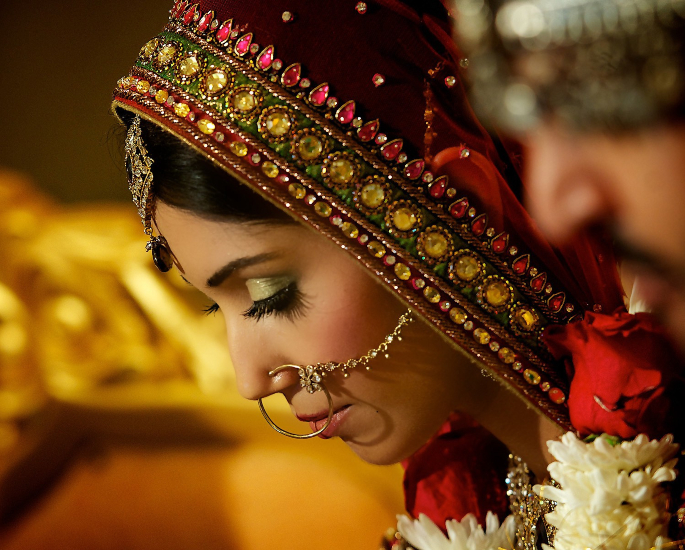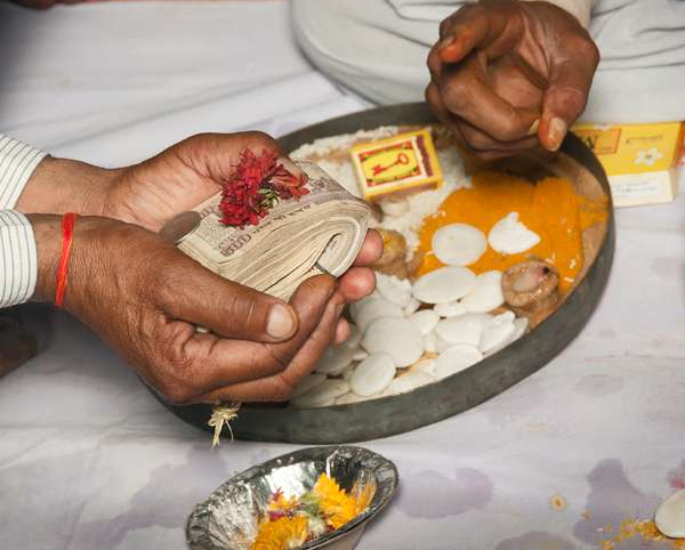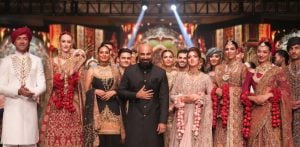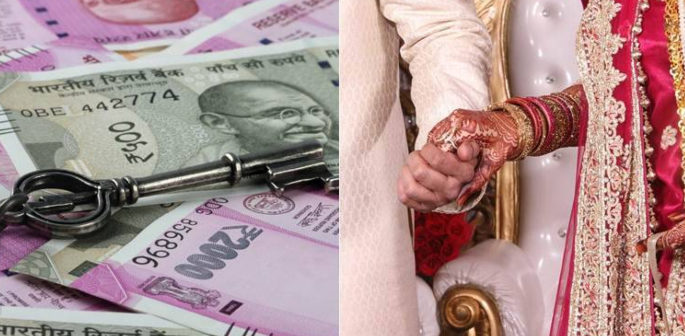Fear of divorce can be a hindrance to getting married.
Finding a Desi marriage partner is becoming increasingly difficult for many.
Perhaps a rise in standards has meant a rise in the difficulty of finding someone who matches these standards.
Although marriage is still a key component of the South Asian community, the demands in what an individual expects in their Desi marriage partner are increasing.
From career expectations to the splitting of household chores; this newfound modernity of the Desi community can cause difficulty in finding a partner with common ground.
DESIblitz explores a variety of reasons why both men and women are having trouble finding a Desi partner for marriage.
Why are there Difficulties?
In the 21st century, expectations of a Desi partner are continuing to rise, with individuals looking for more in their ideal partner.
Previously, one may say that it was easier to find a partner because there were fewer expectations and demands.
In addition, there was a lot of support from the extended family, where expectations were often ‘masked’ for marriages to proceed.
However, now people may not meet the new expectations, and many do not want to settle for less or what is deemed as ‘average’.
So, there is a cycle of high expectations with no one matching up to the perceived standards.
These expectations are related to many factors that determine whether someone will want to marry another person or not.
What Difficulties do both Men and Women Face?
Careers
Many of the difficulties in finding a Desi marriage partner stem from the fact that many expect to have a partner with a good job.
There is an expectation to provide for yourself, your partner, and future children, particularly for men.
Thus, many young Desi’s are under pressure to have a stable career, otherwise, they fear they may not find a partner.
This expectation does not just come from people trying to find themselves a partner, it can come from parents too.
Parents can bring children up with the idea that they will struggle to get a partner if they do not have a stable job or income.
Desi men tend to be the ones facing the pressure to fulfill this expectation even more than women, given the stereotype of their role as the ‘breadwinner’.
Desi women who work hard at university may want an ambitious and high-earning husband to complement this, which can be another area where the expectation arises.
Frishta, a 26-year-old accountant from Manchester said:
“You’re having a laugh if you think I am going to marry a man who doesn’t have a degree!
“I spent years at university to make sure I have a nice and comfortable life, and I would certainly expect my husband to help me maintain such a life.”
This type of expectation seems to be more prevalent since the breakout of Covid-19.
The pandemic has impacted the pressure to secure employment and regular income, which could be more damaging for Desi marriages.
In-Laws and Parents

It is common for there to be tension in Desi marriages when in-laws get involved, particularly in areas like household arrangements.
In-laws play a key role in marriages and can hold a huge influence, and some find it difficult to cope with this kind of control or interference.
Conflicts can arise between the couple and the in-laws. Daughters-in-law are often affected most by these.
For example, from not wanting to live with in-laws as opposed to living with them or from not following what in-laws expect from a spouse.
When a couple is getting to know each other or even dating, early incidents with the family can impact the decision to marry.
If the in-laws and the future bride/groom don’t have any middle ground, the relationship can collapse.
Furthermore, parents may disapprove of the choice made by their son or daughter and would still want to find someone they prefer.
This is usually when the choice does not meet the expectations of the parents.
In this scenario, the pressure on the individual to doubt their choice or even feel emotionally ‘blackmailed’ to retract their decision is problematic.
Culture also plays a part in this. There is a focus on caste and faith. Hence, there may be pressure on young Desi individuals to marry someone from the same faith and/or caste.
Also, in-laws can put pressure on men as they’ve got the responsibility of taking care of their daughters.
Perhaps as a result of this, there can be high standards of care and lifestyle to maintain, which can sometimes prove to be too stressful.
Household Chores
Roles, including the responsibility of household chores, are split a lot more in modern times.
However, some still hold the traditional view that it is solely the women’s responsibility to deal with the chores and duties within the home.
This restricted way of thinking can cause many issues, especially when both partners in the relationship have contradicting views on the matter.
In an article for HuffPost, Asavari Singh stated that women are:
“Grappling with generations of patriarchal conditioning and excuse-making for men.”
Even in marriage, conflicts can arise because of the perceived expectations of whose job it is to carry out household tasks.
This can cause conflicts between a wife who is expecting shared household roles, and a husband who isn’t.
It is important that couples agree on the fundamentals like the organisation of the home.
Thus if there are contradicting views on whose responsibility it is to deal with household chores, it is unsurprising that disputes would arise.
Hence, there is still a lot to do in the Desi community to help establish much more equality, especially in the home.
Dowry

The practice of dowries which is centuries old is one that has not dwindled. In fact, it is even practiced amongst South Asian communities in the west.
A dowry is a gift of value given from either the bride or groom to their future spouse upon marriage.
The dowry can be money and other items of value including gold, cars and household items.
Dowry is quite common in South Asian marriages, particularly from the bride’s side for Indians and the groom’s side for Pakistanis.
However, expectations surrounding the dowry can frequently lead to many marital issues.
Difficulty in finding a Desi marriage partner can become affected by those who believe in a dowry or not.
For example, one may expect dowry of a high value while the other in the relationship may not want to give dowry at all.
Hurdles can also arise in defining what the ideal dowry is, especially when both parties struggle to find a middle ground.
In some cases, this tradition is recognised as a protocol to give the groom and his family a false sense of ownership over the bride.
In 2020, an Indian bride refused to marry the groom after he and his family demanded more dowry.
The marriage was cancelled the day before the wedding day, highlighting the seriousness of this tradition.
Although laws have come in to control the dowry exchange, it’s an ever-present pressure that can arise within Desi weddings.
It is not uncommon for many to feel reluctant to get married due to this.
Difficulties Facing Desi’s in the Modern Age
The fact that our society, and the South Asian community too, is becoming more modern, is changing everything.
Finding a partner within this generation is a lot more difficult because of how much cultural progress has been made.
Things that were once taboo are now becoming the norm, and we are moving towards a more accepting society.
However, there is still a lot more cultural progress that needs to be made, which is holding the Desi community back.
An example of this is in the hit Netflix show, Indian Matchmaking.
Although entertaining and easy viewing, Anika Jain for The Stanford Daily stated:
“Indian Matchmaking broadcasts a variety of issues in Indian culture.
“Such as colourism, fatphobia, caste discrimination and misogyny.”
Although these stereotypes are diminshing, the process needs to accelerate in certain parts of the world.
This slow cultural progress in the Desi community may be the reason people face difficulty finding a partner.
The Pressure of Marrying Young

What do Desi’s class as ‘late marriage’? Typically, anything over 28 is late.
Tensions heighten in the race against time to ensure that one marries before they are ‘old’. So, does this mean that the pressure to get married has increased?
People may marry in haste, just to say they got married but then their marriage comes under scrutiny and is questioned. Are they happy and in love or are they merely grateful to be married before 28?
Rather than being happy, their focus has drifted towards having a partner before they turn ‘old’ which may put people off marriage altogether as Desi’s will feel their efforts are wasted.
It is societal pressure that is depriving people of their true happiness.
Times of India reported that many women feel ‘pressurised to marry and relate it to their self-worth’. So, many get married young and neglect their preferences.
The ones who choose to marry ‘late’, may have their confidence knocked down by society’s judgemental nature.
Zakia*, a 21-year-old medicine student from Birmingham said:
“I feel like as a woman, I have an expiry date.
“After a while, no one will want me, because I’ll be too old, so I have told my mum to start lining up potential suitors for me.”
Divorce
Carrying on from the idea of marrying in haste, Desi people can also end up in divorce, and sometimes this can stem from marrying in a rush.
Maybe the marriage did not work out the way they wanted to, or they realised that this person is not for them.
Asim*, a 19-year-old law student from Birmingham, said:
“I am quite young to be thinking about marriage, but I still know that I need to make sure the woman I pick is perfect.
“My family aren’t too fond of divorce, so if we don’t get along, I’ll pretty much be stuck with her for the rest of my life.
“No one in my family has ever been through a divorce, and if they ever did, I don’t think they’d ever be invited to a family function again.”
Although the stigma needs to be removed from divorce, it is still a prevalent topic that has negative connotations attached to it.
Even though a divorce may be the best thing for both individuals, the commonality of divorce may be instilling fear, which can push young Desi’s away from the idea of marriage altogether.
Arranged Marriage Going Out of Fashion?

With divorce becoming more common, arranged marriage is becoming less common.
Previously, arranged marriages were there to ease the difficulty of finding a partner.
However, since the popularity of arranged marriages is starting to weaken, there are more difficulties in finding a Desi marriage partner by oneself.
The person who wants to marry now has the responsibility to find a partner, instead of the elders in the family.
Which does not make things easy as they are expected to find a partner who meets the family standards, as well as their own requirements and expectations.
With arranged marriage, this was easier to achieve, but in the new era of dating, it might not be as smooth sailing as young Desi’s would like.
Online Dating
In a more technologically advanced world, online dating is becoming more common.
Whilst online dating can be an easy and convenient way to meet new people, there are many downsides that can arise from this, catfishing is one of them.
Catfishing is where a person creates a deceptive identity to use on social media. This can be in their personality, their job, and even their appearance.
Amanda Rowe was a victim of catfishing after dating a man for 14 months called ‘Anthony Ray’ on Tinder.
‘Anthony’ was unable to meet Amanda in person due to a busy schedule. Was it really a busy schedule, or did he not want her to see who he really was?
After hiring a private investigator, Amanda discovered he had fake social media accounts and even a separate phone to carry out his catfishing.
Worryingly, this emphasises how risky online dating can be with many young people becoming increasingly skeptical about who they are speaking to.
The ease of catfishing emphasises the difficulties in finding a partner, especially as online dating becomes more prevalent.
Sometimes you may find the perfect Desi marriage partner online, but it may well be a myth.
Alongside catfishing, there are other issues that can arise, especially if relationships break, like stalking, emotional abuse, and blackmail.
For the most part, many people show their true selves on online dating sites. However, often people look different to their online persona, which can sometimes be misleading.
This is because of photo editing and filters that people can easily apply to their photographs which they may use as part of their online dating or social media profile.
Whilst this doesn’t have the malicious aspect of catfishing, a distorted image can still make people feel cheated and deceived.
This is common when people meet in person, only to find the individual looks different from their profile. The internet has meant that such issues are out of control, and are difficult to mitigate.
Modernity: A Blessing or A Curse?
Many of the difficulties in finding a Desi marriage partner have come around because of how modern our world is.
Even though long-standing traditions are evolving, the process of finding a partner has become more complicated.
Social media dangers, societal pressures and financial restraints have heightened in the modern era.
Traditional mindsets have also played a part in the hardship.
Desi’s are trying to focus on themselves whilst still trying to adhere to their families checklist which adds unnecessary stress.
In contrast, South Asians and Desi marriage culture may see this as an adjustment period. Whilst finding a Desi marriage partner can be difficult, forming relationships has become easier.
In the past, the focus was on finding your marriage partner straight away, but now there is more leniency. So, even if one meets a potential suitor but their personalities clash, they can easily move on to find someone else.
However, time will tell if these difficulties ease and the hope is they do so it can benefit future generations.






























































